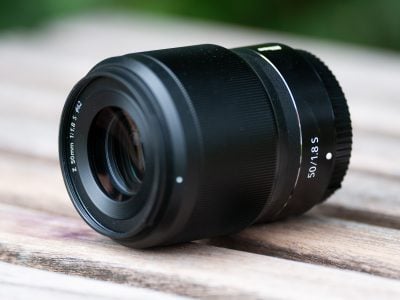Nikon Z 50mm f1.8S review
-
-
Written by Thomas
Intro
The Nikon Z 50mm f1.8 S is a standard prime lens for Nikon’s full-frame Z-series mirrorless cameras. A popular focal length for street photography and general-purpose use, it features an f1.8 focal ratio and joins the Z 24-70mm f4 S and the Z 35mm f1.8 S as the first Z-series lenses on the market. Nikon’s Z-lenses may be the only models currently available with a native Z-mount but thanks to Nikon’s FTZ adapter, existing F-mount lenses can easily be used on their new Z bodies. So the new Z 50mm f1.8 S faces competition from a host of other standard lenses with the F-mount.
As the Z 50mm f1.8 S is a member of Nikon’s high-end “S” line it is expected to perform on a very high level. To find out whether the new Nikon Z 50mm f1.8 S rightfully carries the “S” moniker I tested its optical qualities on the 45MP Z7 body against a few other lenses of which the Zeiss 55mm f1.4 Otus is my current reference standard lens. So if you’re interested in how Nikon’s second prime lens for their new Z system performs, you’ve come to the right place! PS – if you’re interested in the other Z lenses in Nikon’s line-up check out our in-depth reviews: Nikon Z 14-30mm f4.0 S review / Nikon Z 24-70mm f2.8 S review / Nikon Z 24-70mm f4 S review / Nikon Z 35mm f1.8 S review / Nikon Z 85mm f1.8 S review.
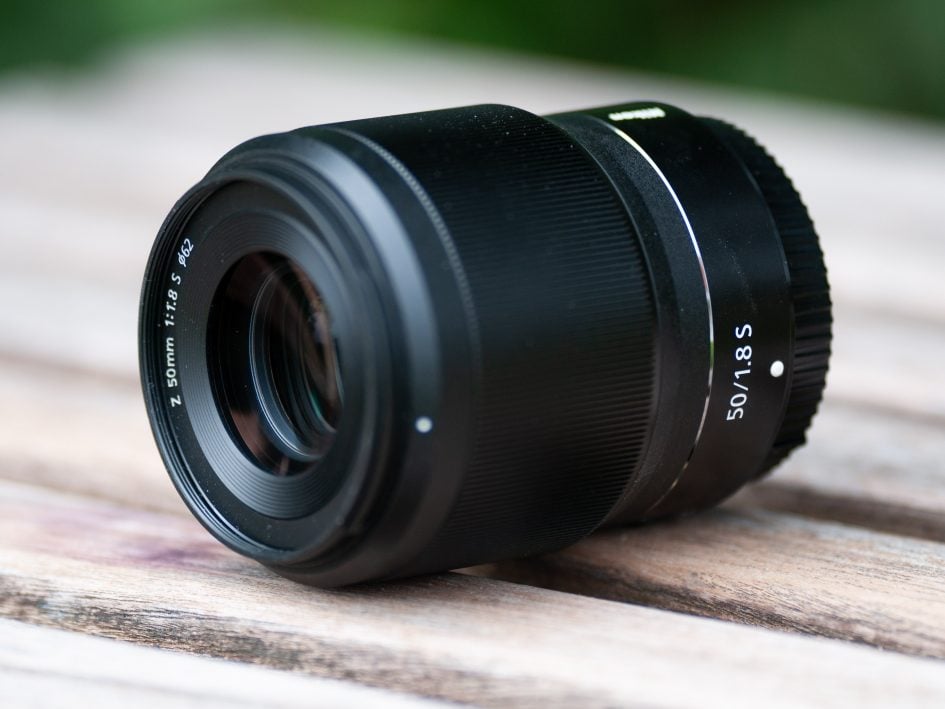
Facts from the catalog
As usual I’ll have a look at the technical data of the new Nikon Z 50mm f1.8 S first. I’ve rated the features with a [+] (or [++]), when it’s better than average or even state of the art, a [0] if it’s standard or just average, and [-] if there’s a disadvantage. For this comparison I use the Nikon AF-S 50mm f1.8G (“F Nikkor” for short) and the Zeiss 55mm f1.4 Otus (“Otus” for short).
Size (diameter x length): 76 x 87mm (3.0 x 3.4in.). The lens hood adds 40mm and is 88mm in diameter. The F Nikkor is 72 x 53mm and the Otus is 92 x 117mm + 32mm for the lens hood. For an apples-to-apples comparison one has to allow for the differences of flange distance between the Z-mount (16mm) and the F-mount (46.5mm). So these 30.5mm (1.2in.) have to be added when using the F Nikkor or the Otus – either on an F-mount DSLR like the D850 or by mounting it via the FTZ adapter on a Nikon Z body. [+]
Weight: 412g (14.6 oz.) plus 27g for the lens hood. The F Nikkor is only 185g (6.5 oz.), the Otus 948g (33.4 oz.) plus 64g for the metal lens hood. Add another 133g (4.7 oz.) for the FTZ adapter to use them on a Z7. [+]
Optics: 12 elements (including 2 special dispersion and 2 aspherical elements) in 9 groups which is a similarly complex design as the Otus. Both the Nikon 50mm f1.8G and f1.4G are much simpler designs. The new Nikon Z 50mm f1.8 S uses Nikon’s Nano-Coating to reduce flare, glare and ghosting. [+]
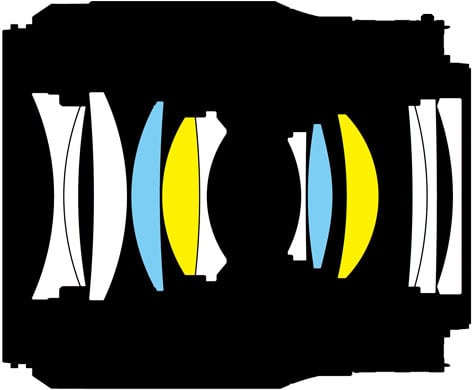
Closest focus distance is 0.4m (15.7in.) with a magnification of 1:6.7. In my test I was able to get down to 1:6 at 0.38m with manual focus. The magnification of the new Nikon is comparable to the other lenses. A magnification of 1:10 is achieved at 0.59m. [0]
Filter-thread: 62mm. The F Nikkor has 58mm, the Otus 77mm. [+]
Image stabilization: The lens offers no optical stabilization. But the Nikon Z bodies provide built-in sensor-shift stabilization over 5 axis – plus an optional electronic stabilization in video mode. The F Nikkor and the Otus also have no optical image stabilization built in but the body-based image stabilization of a Nikon Z body provides roll, pitch, and yaw correction when used on the FTZ adapter. [0]
Auto focus: Yes with built-in AF drive. Manual-focus override is by simply turning the focus ring – if you didn’t assign another operation to this multi-function ring. The focus ring has a variable gearing that allows for very precise manual focus when turned slowly. Unfortunately this feature cannot be switched to linear gearing which makes smooth focus pulling for videographers almost impossible. Focus on the F Nikkor and the Otus works similarly with the only differences being a linear gearing and that the focus ring does only that: focusing. [+]
Covers full frame/FX or smaller. Same with the alternatives. [+]
Price: The lens has a list price of 680 EUR (incl. 19% VAT) / 600 USD. The F Nikkor goes for roughly a third (220 EUR / 220 USD) while the Otus has an exorbitant asking price of 3200 EUR / 4000 USD. [+]
Comes with a soft pouch and the lens hood is included, reversible for transport. That’s similar to the F Nikkor but I must say the new pouches for the Z lenses so far are disappointing: the material is flimsy and the pouch has no strings to pull it close. So if you put the lens in your bag it might easily slip out of its pouch and bang around unprotected. That being said, the Zeiss Otus does not even come with a pouch. [0]
Distance information is relayed to the camera, so the camera and flashes can do all the advanced exposure-related stuff with this lens. Same for most alternatives (including the F Nikkor) except for the Zeiss Otus which does not generate distance information. The new Nikon Z 50mm f1.8S does not have a distance scale or dof markers – like almost any focus-by-wire lens for mirrorless systems. Do I miss it? Well, sometimes. But you can shoot perfectly without one. [+]
Aperture ring: the multi-function control ring of an S-lens can be assigned to operate the aperture, exposure compensation or focus. It automatically falls back to its customary focus control when the lens is switched to manual focus. Although the lens control ring has not the same benefit as having a focus ring plus a dedicated aperture ring on the lens it gives you more flexibility to control one of the more important shooting parameters directly from a nice ring on the lens. The F Nikkor and most other alternatives don’t have an aperture control ring. The Zeiss Otus offers one but that is of no use as the Z7 (unlike the D850) does not allow to control the aperture from there. [+]
Sealing: yes, a rubber grommet at the lens-mount plus further special weather-sealing throughout the construction. The F Nikkor only has the sealing at the lens-mount, the Otus not even that. [+]
The score in the “features-department” is 0[-]/3[0]/10[+]. So the lens has a very good feature set. It offers the nifty feature of the multi-purpose control ring and is sealed against the weather like Nikon’s pro lenses. Compared to the other Z lenses so far it only lacks a bit in close-up shooting: The Nikon Z 35mm f1.8 S reaches a magnification of 1:4.8 and the Z 24-70mm f4 S could even go down o 1:3.1.
Three standard prime lenses for Nikon
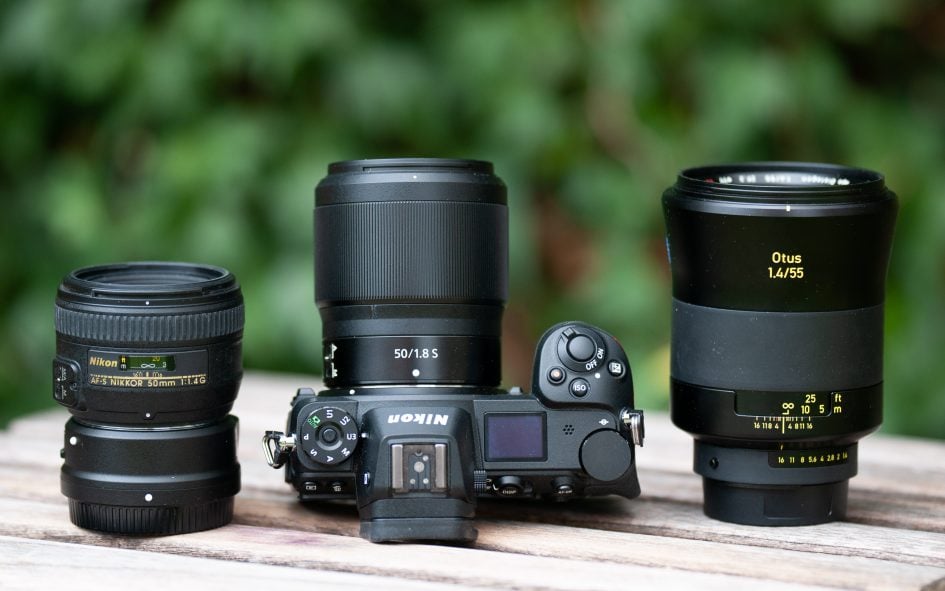
Above from left to right: Nikon 50mm f1.4G on Nikon FTZ adapter, Nikon Z 50mm f1.8 S, Zeiss 55mm f1.4 Otus (needs adapter)
Alternatives
The market for standard prime lenses is pretty crowded but no other manufacturer offers any lens for Nikon’s Z-mount so far. So for alternatives we have to look at F-mount lenses which can be used mounted on Nikon’s FTZ adapter – adding another 31mm in length and 133g in weight:
- Nikon offers the AF-S 50mm f1.8G ED from 2011 for 220 EUR / 220 USD or the 2/3 of a stop faster AF-S 50mm f1.4G from 2008 for 440 EUR / 450 USD. For more information on the latter see my Nikon 50mm f1.4G review where it came Highly Recommended.
- Tamron’s stabilized SP AF 45mm f1.8 Di VC USD from 2015 goes for about 430 EUR / 400 USD. The only stabilized lens of the alternatives earned a Highly Recommended in my Tamron SP 45mm f1.8 VC review. Its optical stabilization was good for 2-3 stops on a D810. The Nikon Z bodies add roll compensation – which from experience takes a little jitter away but does not add another stop of stabilization. The Tamron also has the unique benefit of providing up to 1:3.4 magnification in close-up shots.
- Sigma offers the AF 50mm f1.4 DG HSM Art from 2014 for 700 EUR / 950 USD. See my Sigma 50mm f1.4 Art review where it came Highly Recommended. The Sigma Art is also a big and heavy lens although not as extreme as the Zeiss Otus. Still: mounting it on the FTZ adapter the Sigma Art has a diameter of 85mm, a length of 130mm and a weight of 950g (w/o lens hood).
- The Zeiss 55mm f1.4 Otus from 2015 is my current reference standard prime lens. But it costs a whopping 3200 EUR / 4000 USD – and it’s manual focus only! But its build quality is unsurpassed and the optical performance is top notch. It earned a Highly Recommended in my Zeiss Otus 55mm f1.4 review.
- Samyang has the manual focus 50mm f1.4 AS UMC from 2015 which costs 430 EUR / 400 USD.
Another alternative?
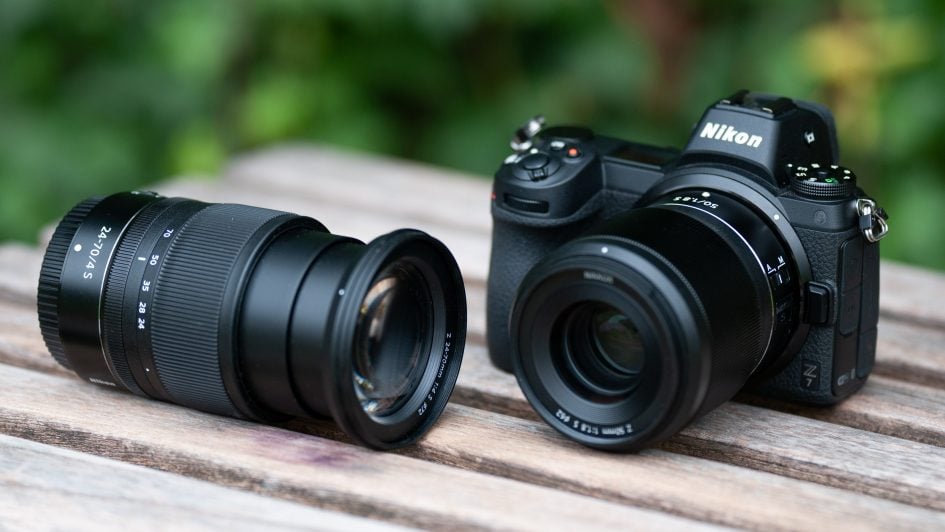
Above: Nikon Z 24-70mm f4 S vs. Nikon Z 50mm f1.8 S on Nikon Z7
Finally you might also consider the new Nikon Z 24-70mm f4.0S as an alternative. It has the benefit of covering a 2.9x zoom range reaching 40% further at the long end and going 37 degrees wider at the short end. It does offer only an f4.0 focal ratio but is of similar size and weight as the Z 50mm f1.8S – at least in its retracted state. It doesn’t need an adapter like the other alternatives above and offers very good optical performance. Plus it comes pretty cheap if you buy it in a kit together with the Z7 camera (600 EUR / 750 USD). It got a Highly Recommended in my Nikon Z 24-70mm f4S review.
Focus
Focus accuracy and repeatability is critical to consistently produce sharp shots especially with large aperture lenses. Repeatability (the accuracy of focus on the same subject after repeated focus-acquisition) of this lens is very good (measured 98.2% in Reikan FoCal) with no outliers over a series of 40 shots. There is only little focus variation whether the lens focuses from a closer distance or from infinity.
The lens focuses in around 0.5 sec from infinity to 0.6m (1:10 magnification), which is pretty fast. Hunting didn’t occur under the well-lit test conditions. The focus/control ring is 38mm wide. Its surface is not rubberized but as it moves super smooth and can easily be operated with one finger the finely knurled metal surface is well up to its task.
AF-operation of the new lens is barely audible from the outside. But if you record video with the built-in microphone the AF-drive still produces a slight buzz. This lens is clearly not as quiet as the Nikon Z 24-70mm f4 S. If you use the control ring on the lens to change the aperture this works smoothly and without noise.
As you pull focus, you’ll notice a very slight focus breathing: the image becomes less magnified at closer focusing distances. When I adjusted the focus from infinity to 0.6m on the new Nikon, I measured a 0.7% decrease in magnification. This is totally inconspicuous and should please videographers.
Image stabilization
To test the effectiveness of the image stabilization with the Nikon Z 50mm f1.8 S on a Z7 body, I did a series of 140 test-shots hand-held. For comparison I also shot the Nikon 50mm f1.4G and the Zeiss 55mm f1.4 Otus on the FTZ adapter. This should give an impression of how good adapted lenses are stabilized which only benefit from 3 axis (roll, pitch, yaw) as apposed to the 5 axis stabilization the Nikon Z bodies provide for Z-mount lenses. I tested with shutter speeds from 1/50 of a second down to 0.6 sec. I used the shots at 1/50 sec with VR=OFF as reference of how good my hand-holding was at the time of the test and Reikan FoCal did the chore of evaluating the sharpness of all 460 test-shots.
Here’re the details for the Z Nikkor first: With VR=ON the combo produced results down to 1/12 sec (2 stops) which were clearly more consistently sharp than at 1/50 sec with VR=off. At 1/6 sec (3 stops) the results were comparable to 1/50 with VR=off. At 1/3 sec (4 stops) there were 30% clearly blurred images and 0.6 sec produced hardly any usable results. This is a 3 stop advantage from stabilization.
How did the adapted lenses fare? The Nikon AF-S 50mm f1.4G achieved a similar result as the Z Nikkor right down to 0.6 sec. So there was no discernible difference in stabilization in this test. The Zeiss 55mm f1.4 Otus is a much heavier and longer lens than the other two so the question was how size and weight influences the stabilization. There were indeed slight differences in the blur characteristic of the Zeiss Otus: there were a little more slightly blurred images but less heavily blurred ones at shutter speeds of 1/6 and longer. So all-in-all I couldn’t find a significant difference in the stabilization of adapted lenses versus the native Z Nikkor in my test.
Next check out my quality results!
Check prices on the Nikon Z 50mm f1.8 S at Amazon, B&H, Adorama, or Wex. Alternatively get yourself a copy of my In Camera book or treat me to a coffee! Thanks!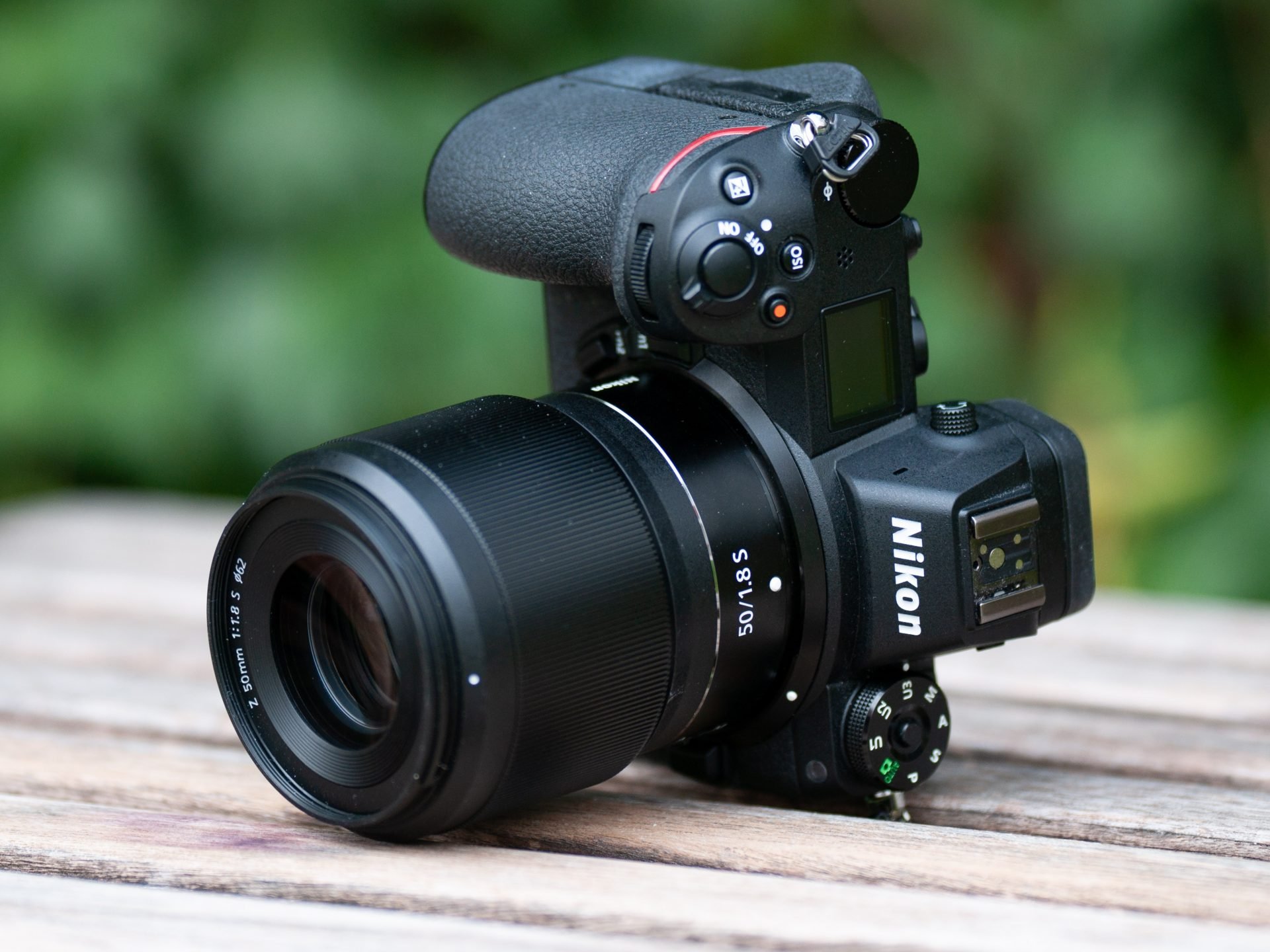
 The Nikon Z 50mm f1.8S is a very good standard prime lens for owners of Z-series mirrorless bodies: its optical performance is right up there with the much heavier and more expensive Zeiss 55mm f1.4 Otus including longitudinal color aberrations - which is no small feat. The size and weight of the Z Nikkor makes it a good match for the compact Z-series bodies it's designed for although it is not the smallest lens. The Z Nikkor also focuses fast and reliably and is sealed thoroughly. And finally the lens produces quite pleasing Bokeh that's not far behind the rendering of very good f1.4 lenses and to me, actually surpasses Nikon's own 50mm f1.4G. This overall performance justifies the price and deserves a Highly Recommended!
The Nikon Z 50mm f1.8S is a very good standard prime lens for owners of Z-series mirrorless bodies: its optical performance is right up there with the much heavier and more expensive Zeiss 55mm f1.4 Otus including longitudinal color aberrations - which is no small feat. The size and weight of the Z Nikkor makes it a good match for the compact Z-series bodies it's designed for although it is not the smallest lens. The Z Nikkor also focuses fast and reliably and is sealed thoroughly. And finally the lens produces quite pleasing Bokeh that's not far behind the rendering of very good f1.4 lenses and to me, actually surpasses Nikon's own 50mm f1.4G. This overall performance justifies the price and deserves a Highly Recommended!



